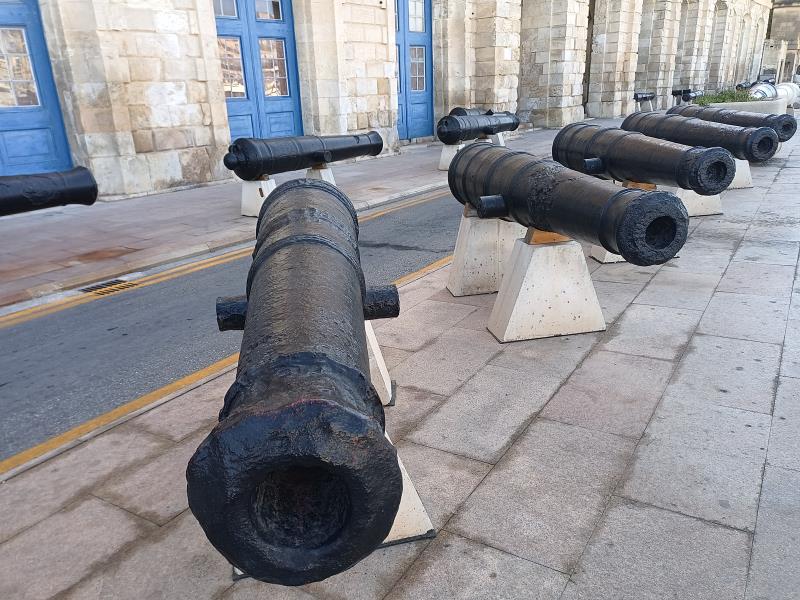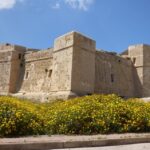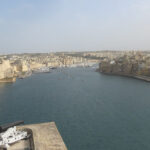| Malta Short Let: Cozy Stay in Gzira | |
|
Sliema Area Modern Designer Finished 2 Bedrooms + Games Room. First floor with Maltese Balcony Large back Terrace with swinging sofa Fully Airconditioned + Full Kitchen 3 TVs, including 65” with backlight. |
 |
|
Book Now: Google Travel | Direct (Cheapest) | Booking.com | Airbnb |
|
The Great Siege of Malta in 1565 is one of history’s most iconic defenses, where a small force on the island held its ground against an overwhelming Ottoman fleet. This battle exemplifies how strategic fortifications, clever tactics, and unyielding resilience allowed Malta to resist, mirroring similar legendary sieges. The Three Cities — Birgu, Senglea, and Bormla — became the heart of Malta’s defense, standing as fortified beacons through which Malta’s story of resilience would unfold across centuries.
Beyond 1565, Malta’s Three Cities continued to serve as bastions of defense. During the French invasion in 1798, they once again became a battlefield, and their role as strongholds continued into the Second World War, where they helped sustain the island during the crucial Malta Convoys, a legacy further explored in this article on the Three Cities history.
Birgu, which served as a primary stronghold in 1565, showcases fortifications and defenses that withstood immense pressure, much like the walls of Constantinople and Vienna in their respective sieges. In Bormla, fortifications also helped protect the island, demonstrating the importance Malta placed on robust defense infrastructure. Even Senglea contributed to this legacy, highlighting the critical role of the Three Cities as the backbone of Malta’s survival.
1. Siege of Tyre (332 BCE)
- Context: The Siege of Tyre occurred during Alexander the Great’s campaign against the Persian Empire. The city of Tyre, a fortified island stronghold, resisted Alexander’s forces for seven months.
Similarities to Malta:
- Overwhelming Attacker: Alexander’s army was much larger and better equipped than the Tyrians, similar to the numerical superiority of the Ottoman forces.
- Strategic Use of Fortifications: Tyre’s defenses were formidable, including thick walls and the fact that it was an island. This situation echoes Malta’s use of forts and natural defenses.
- Innovative Tactics by Defenders: The Tyrians employed countermeasures such as fireships to disrupt Alexander’s naval operations, akin to how the Knights at Malta used innovative defensive techniques like counter-mining and concealed gun positions.
- Outcome: Despite Tyre’s efforts, Alexander ultimately captured the city by constructing a causeway to breach its defenses, showing that sheer determination and innovation could eventually overcome fortified positions, a scenario that the Ottomans failed to replicate at Malta.
2. Siege of Masada (73-74 CE)
- Context: During the First Jewish-Roman War, a group of Jewish rebels fortified themselves atop Masada, a desert plateau with steep cliffs, making it nearly impregnable. The Romans, led by General Flavius Silva, laid siege to the fortress.
Similarities to Malta:
- Numerical Disparity: A small group of Jewish zealots faced a large Roman force, echoing the Knights’ situation against the Ottoman army.
- Use of Natural Defenses: The rebels took advantage of Masada’s natural defensive position atop a plateau, just as the Knights leveraged Malta’s rugged terrain and fortifications.
- Psychological Elements: The prolonged siege and the defenders’ determination impacted Roman morale, much like the Knights’ resistance affected the Ottomans.
- Outcome: The Romans eventually breached Masada’s defenses by building a massive ramp, but the defenders committed mass suicide rather than surrender. This reflects how desperate and resilient defenders can challenge larger forces even when facing inevitable defeat.
3. Siege of Constantinople (717-718 CE)
- Context: The city of Constantinople was besieged by the Umayyad Caliphate, which sought to conquer the Byzantine Empire’s capital. The Byzantines, though vastly outnumbered, held out for over a year.
Similarities to Malta:
- Smaller Defensive Force: The Byzantine defenders were significantly outnumbered by the invading Arab forces, similar to the situation at Malta.
- Use of Advanced Fortifications: Constantinople’s formidable walls, combined with the use of Greek fire (an incendiary weapon), parallel the Knights’ sophisticated fortifications and artillery innovations.
- Naval and Psychological Warfare: The Byzantines effectively utilized their navy and psychological tactics to undermine the morale of the besiegers, much like how the Knights disrupted Ottoman siege operations and maintained high morale.
- Outcome: The Byzantines successfully repelled the Arab siege, aided by harsh winter conditions and effective use of Greek fire, demonstrating how defenders can leverage environmental factors and technological advantages to resist a stronger foe.
4. Siege of Vienna (1529)
- Context: The first Ottoman attempt to capture Vienna marked a significant conflict in the Ottoman-Habsburg wars. The Ottomans, under Suleiman the Magnificent, laid siege to the city, which was defended by a much smaller force.
Similarities to Malta:
- Large Attacker, Small Defender: The Ottomans’ large army vastly outnumbered the defenders, mirroring the dynamics seen at Malta.
- Strategic Use of Fortifications: Vienna’s fortifications were critical in holding back the Ottoman assault, just as the Knights relied on Malta’s forts.
- Failure to Achieve a Breach: The Ottomans struggled to create a decisive breach in Vienna’s defenses, much like their difficulty in overcoming Malta’s fortifications.
- Outcome: The siege ended in an Ottoman retreat due to weather conditions and the defenders’ resilience. This parallels the Great Siege of Malta, where the Ottomans withdrew after being unable to overcome the Knights’ defenses.
5. Siege of Leningrad (1941-1944)
- Context: During World War II, the German Army and its allies besieged the Soviet city of Leningrad for nearly 900 days. The city’s defenders and civilians endured extreme conditions, including starvation and constant bombardment.
Similarities to Malta:
- Outnumbered and Outgunned Defenders: The Soviets in Leningrad, like the Knights, were heavily outnumbered and faced a larger, better-equipped enemy force.
- Prolonged Siege and Attrition: Both sieges involved lengthy engagements where the defenders suffered significant casualties but maintained their resolve.
- Psychological and Moral Determination: The determination of Leningrad’s defenders to hold out against the Axis powers mirrors the Knights’ willingness to fight to the last, despite facing overwhelming odds.
- Outcome: The Soviets eventually lifted the siege through sustained resistance and counter-offensives, similar to how the Knights turned the tide at Malta by capitalizing on their enemies’ weaknesses.
6. Siege of Dien Bien Phu (1954)
- Context: The French military fortifications at Dien Bien Phu in Vietnam were besieged by Viet Minh forces during the First Indochina War. The French assumed their fortified position was unassailable, but the Viet Minh, under General Vo Nguyen Giap, systematically neutralized their defenses.
Similarities to Malta:
- Fortifications vs. Siege Warfare: The French, like the Knights, relied on fortified positions to resist a larger force. However, the Viet Minh’s tactical ingenuity and strategic artillery placements gradually overwhelmed the defenders.
- Underdog’s Victory: In contrast to Malta, where the defenders triumphed, at Dien Bien Phu, it was the besiegers who succeeded, illustrating how exploiting weaknesses in a seemingly impregnable position can still lead to victory.
- Logistical Challenges: Both sieges highlight the importance of logistics. The French were cut off from supplies, leading to their defeat, whereas the Knights managed to maintain supply lines despite the Ottoman blockade.
Explore More on Malta’s Legendary Sieges and Naval Tactics
- Comparing the Military Tactics of the Two Great Sieges of Malta: 1565 and 1798
- Military Tactics During the Great Siege of Malta, 1565
- Sieges Similar to the Great Siege of Malta, 1565
- Military Tactics Used by the French in the Invasion of Malta, 1798
- Maltese Pirates and Their Naval Tactics
- Turning the Tide: How the Knights Exploited Ottoman Mistakes During the Great Siege of Malta
- Fortress Malta: A History of Sieges and Survival
As these sieges illustrate, the Great Siege of Malta is far from a solitary story of resilience and strategy. From the Knights of Malta to the outposts of Tyre and Masada, these historical sieges share tactics, courage, and strategic ingenuity, providing timeless lessons in defense and the art of warfare.
Conclusion
The Great Siege of Malta shares many characteristics with other famous sieges throughout history. These include the David vs. Goliath dynamic, the critical role of fortifications, innovative defensive tactics, and the ability of smaller forces to exploit the mistakes or limitations of larger armies. In each case, the defenders demonstrated how determination, strategic use of terrain, and innovative warfare could defy overwhelming odds, whether in ancient, medieval, or modern contexts.
These historical sieges collectively emphasize the idea that strong defenses and tactical ingenuity can overcome numerical disadvantages, with morale and psychological resilience often tipping the scales in favor of the underdog. For insights into how the Knights used these strategies, explore How the Knights Exploited Ottoman Mistakes. Additionally, for a broader look at Maltese military history, refer to The History of the Three Cities.
Learn More about the three cities:








